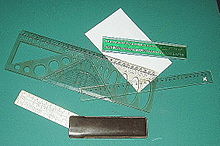ruler
A ruler is an aid for drawing straight lines , especially straight lines ( lines ), and for measuring line lengths (in the picture from 1 mm to 300 mm). There are curve rulers for drawing curved lines, e.g. B. for parabolas ( parabolic template ) and straklatten .
Special cases or analog tools are the folding rule or yardstick , measuring rod and leveling rod (surveying), triangular ruler and square , set square , transverse ruler , reticle and glass ruler (scales for optical instruments), magnetic incremental encoders , distance dividers .
Structure and material
While early rulers only had a straight edge, modern rulers usually also have a scale with which lengths can be measured. Frequently, scales are also applied on both sides, sometimes in different units of measurement. The length of the rulers can be very different, students mostly use plastic rulers (10–30 cm), rulers up to 100 cm are not uncommon in companies and in the workshop, and rulers up to 200 cm are also found in mechanical engineering. For more precise geometric constructions and drawings in schools and training, usually transparent plastic rulers are used, as these enable a more precise drawing of a line. The material allows you to see areas of the sheet and markings under the ruler while you are drawing. This is a great advantage over rulers made of wood or metal, which is particularly useful for technical drawing . Rulers for drawing usually have either small knobs on the underside or a recess running along the entire edge. This is to prevent the otherwise occurring capillary forces from sucking the ink under the ruler. Some rulers also have openings of different shapes (circles, ellipses, etc.) inside, which serve as templates. Such tools can be described as a combination of ruler and template.
To draw
The line is drawn by placing the ruler at certain points on the drawing area and then tracing the edge of the ruler with the pen . This transfers the shape of the edge onto the paper as a line .
Production and workshop
Metal rulers, mostly made of flexible steel, are also used in metalworking and in other areas of craftsmanship . These are more robust and the cut edges are more wear-resistant. In contrast, fixed rulers made of steel or aluminum are used for picture framing and bookbinding.
Steel rule
A steel rule is a stiff, yet flexible rule made of mostly stainless steel with a length division. The scales and numbers are engraved or etched.
Straight edge
In metal processing there are also straight rules with which you can use the light gap method to check how a workpiece surface is. For use in industry, rulers made of steel and aluminum in various cross-sections are also produced. B. can be used to align machine parts. Like straight rulers, these rulers usually have no scale and can therefore not be used to measure length.
Cutting ruler
In addition, there are also cutting rulers that are used to cut along the edges of the ruler with a knife or scalpel and thus enable straight cutting edges. Cutting rulers are usually very heavy so that they do not slip while cutting, and are used by architects, in model making or in bookbinding, among others.
Historical
- Early rulers had no scale, but had a defined length (e.g. Pachys in Greece).
- Even today some rulers have a hole at the end through which a rag, cloth or sponge could previously be threaded to clean slates .
See also
- Pawn ruler
- Folding rule
- Golomb ruler
- List of measuring tools
- Tape measure
- Benchmark
- measuring stick
- meter
- Sine ruler
- Transverse scale



